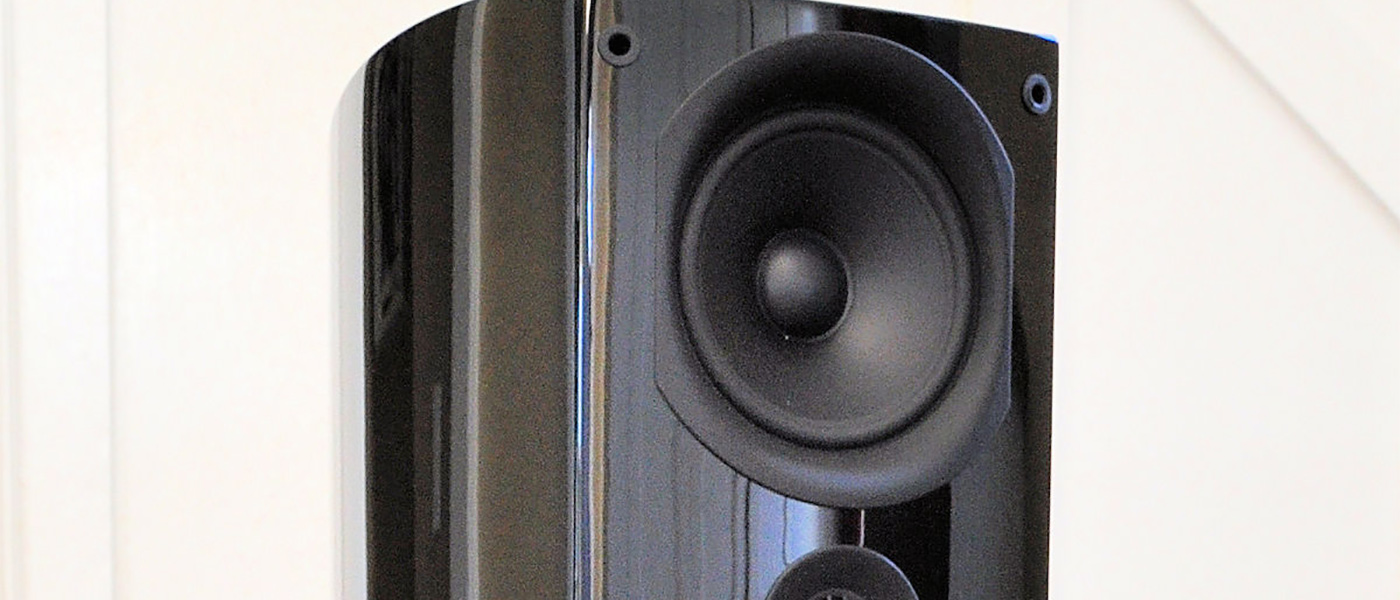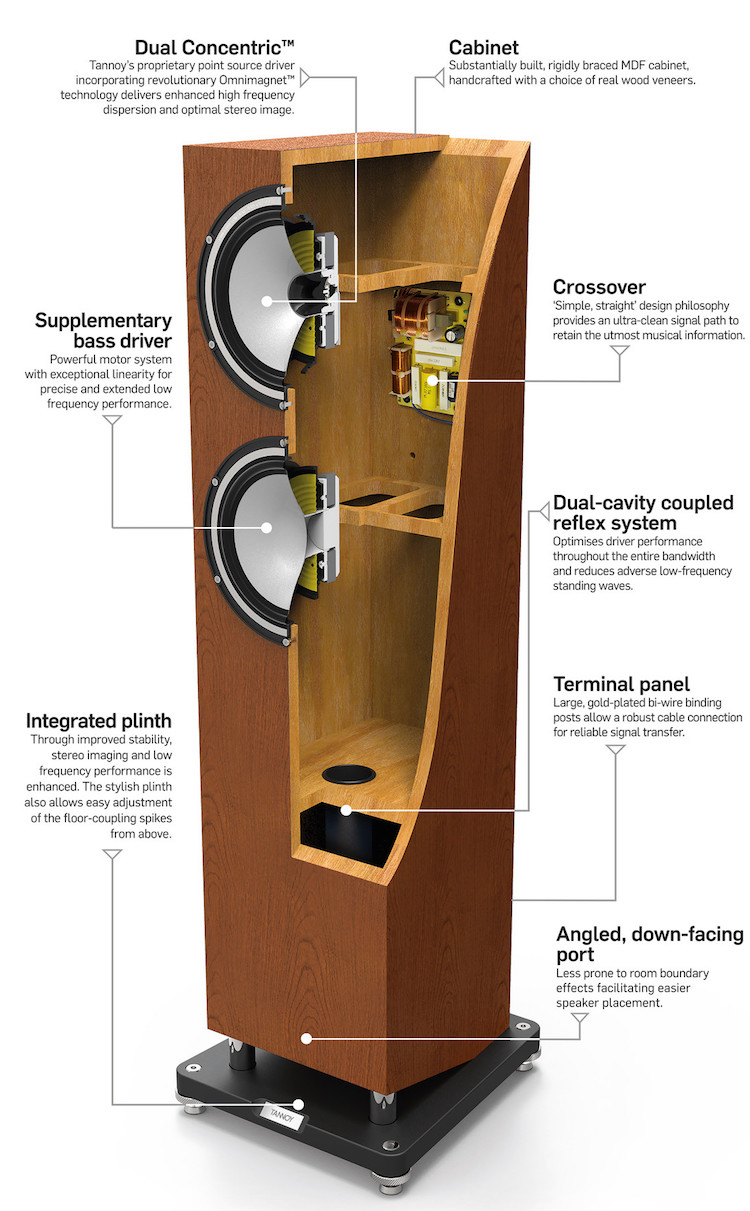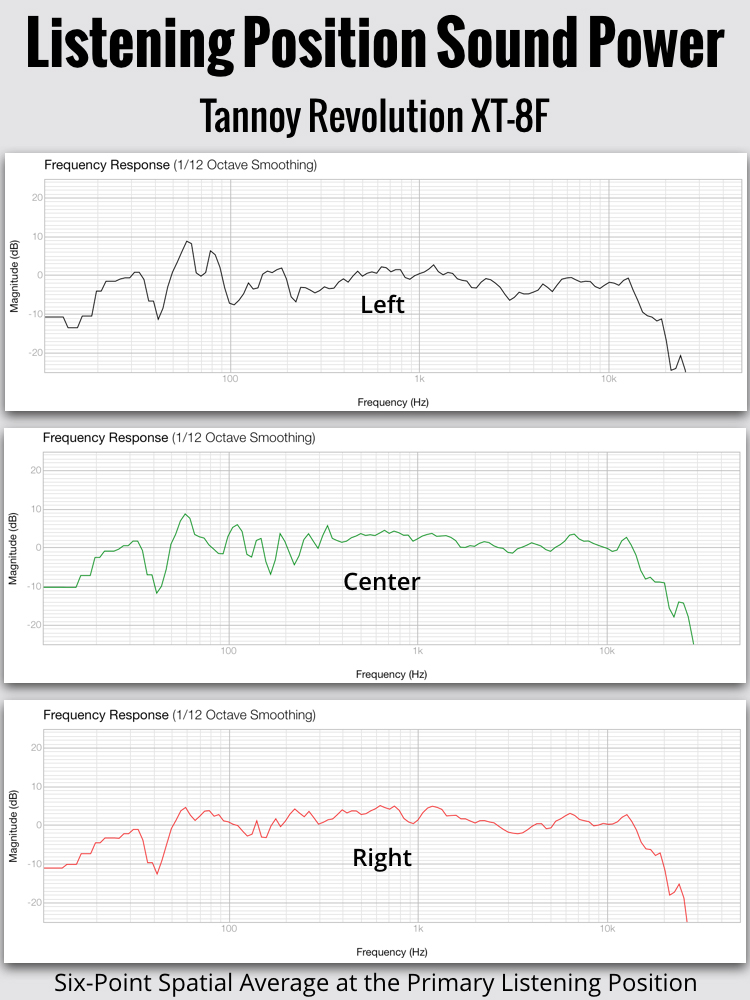The XT 8F is the flagship of Tannoy’s new Revolution XT line. Its 8-inch Dual Concentric and 8-inch supplemental woofer are both made in-house. The full-range Revolution XT 8F tower begins a new chapter in Tannoy’s distinguished history of great speakers with Dual Concentric drivers.
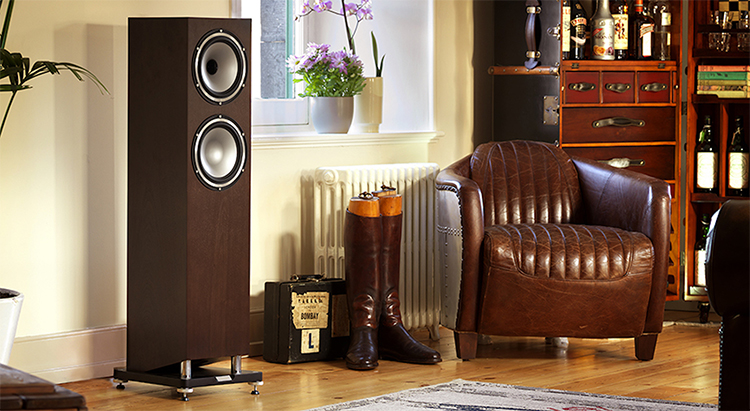
Tannoy Revolution XT 8F Floor-Standing Speakers
- Omnimagnet Dual Concentric driver provides exceptional clarity at low volume levels
- Very even horizontal dispersion
- Big cone area allows louder-than-sane-levels without strain
- Bass extends all the way down to 20 Hz in-room
- Elegant design and high finish quality; blends well with contemporary room decor
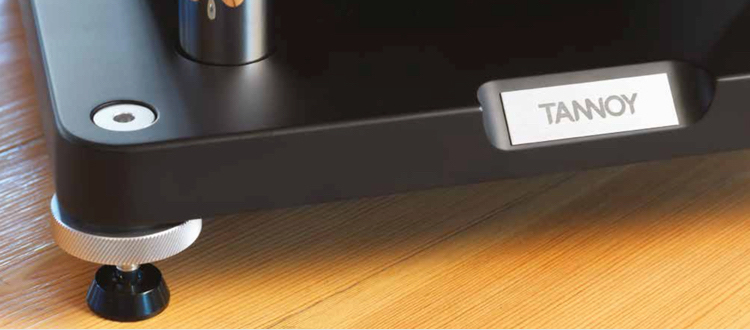
The Revolution XT line is a landmark for 90 year-old Scottish speaker specialist Tannoy. It introduces their next-generation Dual Concentric: “Omnimagnet.” Like Tannoy’s previous Revolution DC6T the Revolution XT 8F is a 2.5-way tower, albeit with larger drivers. Omnimagnet’s woofer and tweeter share a magnet, like TAD’s concentric driver in the CE1.
DESIGN:
3-Driver, 2.5-Way Floor-standing Speakers with Twin Coupled Cavity Bass Reflex Cabinet
DRIVERS:
Omnimagnet Dual Concentric with 1” Pei Ring Radiator Tweeter and 8” Paper-cone Woofer; 8” Paper-cone Supplemental Bass Driver
CROSSOVER FREQUENCIES:
250 Hz, 1.8 kHz
SENSITIVITY:
91 dB/2.83V/1M
NOMINAL IMPEDANCE:
8 Ohms
RECOMMENDED AMPLIFIER POWER:
25 – 200 Watts
Available Finishes:
Dark Walnut, Medium Oak
DIMENSIONS:
42.5” H x 12.5” W x 13.6” D
WEIGHT:
43.9 Pounds/each
MSRP:
$1,300/each
Company:
SECRETS Tags:
Tannoy, Revolution XT 8F, Floor-Standing Speakers, Speakers Review
Omnimagnet is a radical rethink of Tannoy’s signature Dual Concentric driver. The previous Dual Concentric design served Tannoy very well for a long time, so such a clean-sheet overhaul was risky. With Omnimagnet and the Revolution XT 8F, Tannoy pulled it off.
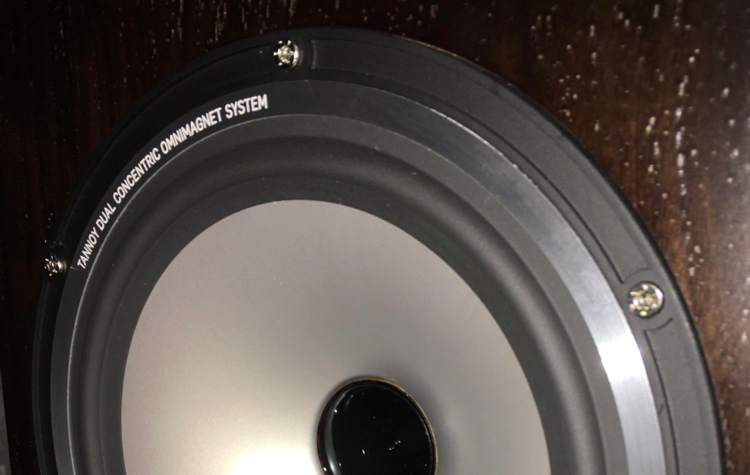
Tannoy invented the concentric driver, and trademarked “Dual Concentric,” in the 1940s. Concentric drivers are special coaxes, just as squares are special rectangles. In a coax, the tweeter can be anywhere as long as woofer and tweeter fit into one unit. In a concentric driver, the tweeter sits centered behind the woofer cone and uses the woofer cone as a waveguide. The theoretical advantages of concentric drivers are true point-source radiation through the midrange and treble and (with good design) smooth dispersion through the crossover.
Secrets Sponsor
I have long appreciated Tannoy’s Dual Concentric-based speakers. As a law student, I followed the late J. Gordon Holt’s example and used five Tannoy DMT studio monitors for stereo and multichannel. When I learned Tannoy designed an all-new Dual Concentric for the Revolution XT line, I was eager to hear the results for myself.
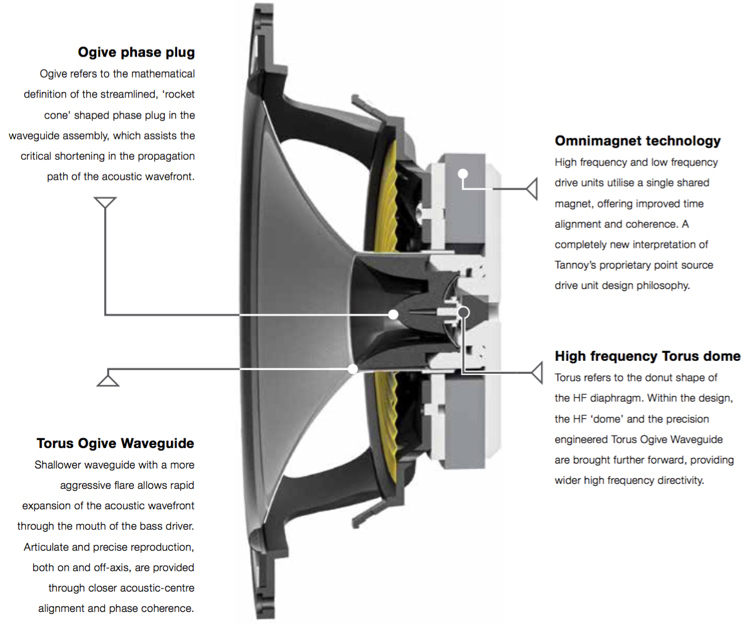
Tannoy’s Revolution XT 8F showcases their new Omnimagnet Dual Concentric driver, simply “Omnimagnet” for the rest of this review. Tannoy claims their Omnimagnet improves treble dispersion, time alignment, and coherence over their previous Dual Concentric platform. See below for cutaways and phase-plug close-ups of the Omnimagnet and its’ longest-lived predecessors: the original “Pepperpot” from the 1940s and the “Tulip” Tannoy introduced in the 1990s. (Both nicknames arise from their distinctive phase plug shapes.) The tweeter locations are circled in blue.
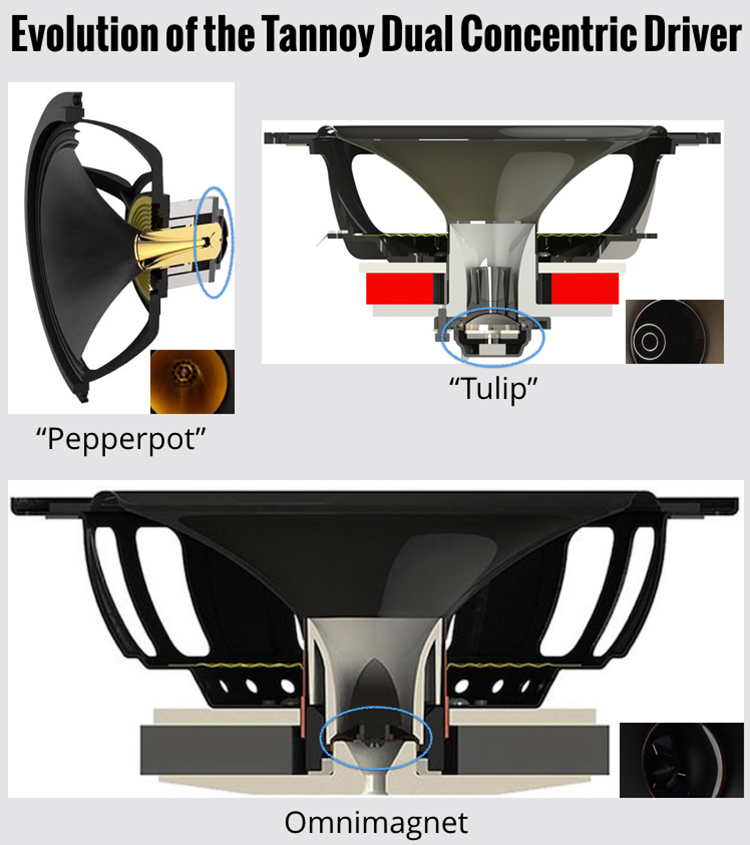
To summarize the differences shown above, Omnimagnet’s tweeter is all new: a 1-inch thermoplastic “Torus” (ring-radiator) rather than the alloy domes used in Tulip and Pepperpot. The new tweeter now sits inside the woofer’s polepiece, not behind the woofer’s motor as in the Pepperpot and Tulip. Omnimagnet’s ring-radiator tweeter fires into the shallow Torus Ogive Waveguide, which promotes wider treble dispersion. Two other big changes from Tulip, the bullet-shaped phase plug and single magnet for both voice coils call back to past Dual Concentrics: Pepperpot used a single magnet for both voice coils, and a short-lived Dual Concentric employed between Pepperpot and Tulip had a similarly bullet-shaped phase plug.
Tannoy’s twin-cavity coupled reflex cabinet provides greater control over woofer excursion than a standard vented cabinet, because it effectively has two tunings rather than just one. Also, the individual cavities are shorter, which prevents formation of long vertical standing waves that can color the upper bass. The downfiring port fires onto a plinth rather than directly into the floor, so bass loading remains consistent no matter the floor surface, speaker height, or speaker tilt.
My review speakers looked great, and fit in with our living room décor. Tannoy finished the trapezoidal cabinets in an attractive espresso-like finish (“dark walnut”) veneer with a matte black plinth and slick metallic accents. The mounting bolt heads bear a vintage Tannoy logo. Tannoy pulled off the neat trick of making a pair of speakers with twin 8-inch woofers look relatively small. Unlike too many other speaker companies, Tannoy clearly pays attention to furniture design trends. Speakers are, after all, audio furniture. The finish, shape, and accents make the Revolution XT 8F look at home in a well-appointed room.
Secrets Sponsor
But I wish Tannoy offered leveling footers other than spikes. Spikes are murder on hardwood floors, and I have never heard sonic benefit from them on any flooring. Tannoy includes spike-cups for wood floors, but the cups do not hold the spikes well when you rotate or move the speakers. So placement is hard to fine-tune without assistance.

Tannoy was kind enough to send me three Revolution XT 8Fs for left/center/right. I placed the left and right speakers at the usual spots in our living room, and the center in front of our fireplace. All three speakers were about 12 feet away from the main listening position. I started with all three speakers aimed directly at the listening position, as recommended by Tannoy’s Dr. Paul Mills: left and right toed-in slightly to cross at my nose, and all three speakers tilted back slightly. However, I ended up with left and right toed-in deeper, so their axes crossed about a foot ahead of my knees and all three speakers level rather than tilted back. This toe-in traded absolute image focus for greater spaciousness and perfect image stability at every position on our 84-inch wide sofa.
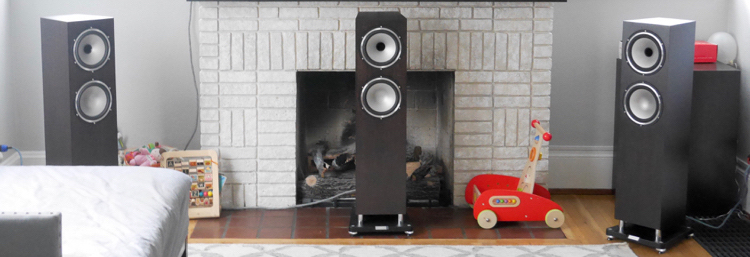
I auditioned the Revolution XT 8F trio with my reference equipment: Oppo disk player, AppleTV, B&O turntable with iFi phono preamp; Anthem MRX with ARC engaged below 500Hz; ATI amp; Pioneer EX in-wall side speakers; and KEF R-Series rear speakers.
Tannoy’s Revolution XT 8F speakers engaged me from the start with an open smooth midrange and deep dynamic bass. They throw a wider soundstage than older Tannoy Dual Concentrics I’ve used, which rarely threw images wider than the speakers’ outer edges. “Jump factor” was hair-raising. Their low-level resolution was the best I’ve heard in this room. We could watch TV several clicks below our usual listening volume and miss nothing. By our second day my wife told me unprompted that she liked them.

Leonardo Dalessandri “Watchtower of Turkey”
While we were preparing to vacation in Turkey, my wife found this captivating video on Vimeo. Our toddler loved it, too so I grew to know it very well. While the cinematography is breathtaking, the soundtrack (excerpted from Ludovico Einaudi’s “Experience”) is even better. Whether in 2-channel or unmixed with Dolby Pro Logic IIx (my preference), the Revolution XT 8F speakers threw a sidewall-to-sidewall soundstage with the kind of slightly blurry image placement one hears at live performances. The Tannoys’ exceptional lower midrange performance brought piano and strings to life with rich and detailed texture. The XT 8F trio provided an addictively immersive and compelling listening experience.

Pink Floyd’s “Wish You Were Here” SACD (5.1-channel) hit the spot with the Tannoy power trio up front. The Tannoys sounded smooth and lush, projecting vivid tone colors on the astral “Shine on You Crazy Diamond,” with keyboards that just floated in mid-air.
This disk begs for immodest levels, and with the Revolution XT 8Fs the soundfield simply grew larger and more immersive as I increased the volume. They never had that edgy, strained, “loud” sound. To be sure, the high-current 200W/8Ohm ATI amp gave them all the power they could want. But big sound requires speakers that can move lots of air without strain at which the Tannoys excelled.
My only sonic critique of note is that the Torus tweeter’s lower treble seemed slightly less delicate and precise than my reference speakers’ ceramic-graphite tweeters. I noticed the difference primarily in the effects in “Welcome to the Machine,” panned between the side surrounds (which use the same ceramic-graphite tweeters) and the front channels. Also, cymbals sparkled but their shimmer didn’t decay quite as cleanly. While the difference was noticeable, it did not detract from the immense enjoyment the XT 8F trio brought me on every piece I played through them.

In 2011, Adele returned from throat surgery to perform at London’s Royal Albert Hall. The video editing is jarring and disjointed, but the sound has luscious hall ambience and less heavy-handed dynamic compression than her studio albums. I think it is her best-sounding release in any format.
The Revolution XT 8Fs perfectly complimented Adele’s prodigious pipes, reproducing the raw emotion in “Set Fire to the Rain” without strain. Often, playing full-throated female vocals loudly will expose a speaker’s crossover points, as the tweeter or (more rarely) the midrange audibly compresses at the bottom of its range. With the XT 8F, there was no sign of overload no matter how hard I pushed.
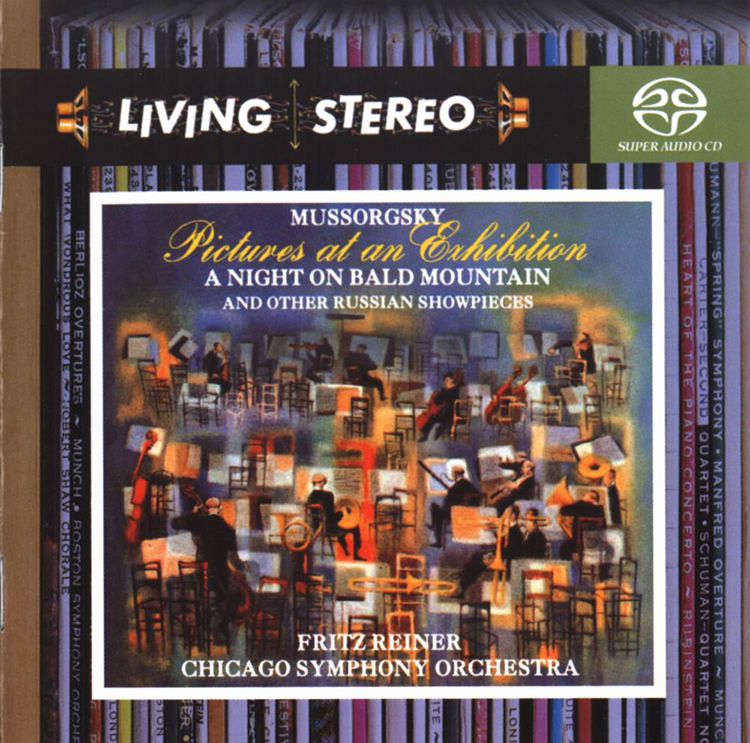
Fritz Reiner and the Chicago Symphony Orchestra, “Mussorsky: Pictures at an Exhibition, A Night on Bald Mountain, and Other Russian Showpieces”
RCA Living Stereo SACD’s are probably the best bargain in all of audio: minimally-miked, highly dynamic recordings of amazing orchestras as they were originally recorded (three-channel stereo) at standard CD prices. Only slight tape hiss, lightly accentuated by the Tannoy Revolution XT 8F compared to my reference speakers for reasons not quite clear to me, stands between a listener and this time machine on disk.
On “The Great Gate of Kiev,” the Tannoy Revolution XT 8F trio brought the tympani drums into our living room, with clearly articulated impacts heralding a tactile wavefront that washed over us as it expanded through the room. Low brass, massed strings, and that big bass drum entered our living room with body and richness. Upper brass came through with just the right amount of bite. Only speakers with deep, full-range dynamic reserve and neutral tonal balance can render an orchestra at full song so stirringly.
On Tchaikovsky’s “Marche Slave,” the XT 8F trio placed instruments perfectly: individual parts came from zones in the soundstage, not distinct points in space, just like a live orchestra. (Have you ever been able to close your eyes at a live orchestral performance and point right at the second clarinet part from sound alone?) I consider big symphonic works the key test of a speaker, and the Tannoy Revolution XT 8F just plain delivered.
Fair warning: this section is necessarily a bit dense. If you only read one section of this bench report, skip down and read around the most sonically revealing measurements: the polar maps.
While one often sees complaints that measurements are useless for judging speakers, research teaches us that a few measurements dominate our perception of speaker sound quality. These measurements are: bass extension, on-axis frequency response flatness and smoothness, and off-axis frequency response smoothness. Accordingly, my bench sections focus on frequency response both on and off-axis, the latter through polar maps that are a huge pain to make but graphically explain previously mysterious aspects of speaker sound in rooms.
I take impedance measurements right after I receive speakers, and send them to the manufacturer to confirm the speakers weren’t damaged in shipping. I take all other measurements after listening to avoid biasing my audition. Here is the Revolution XT 8F’s impedance.
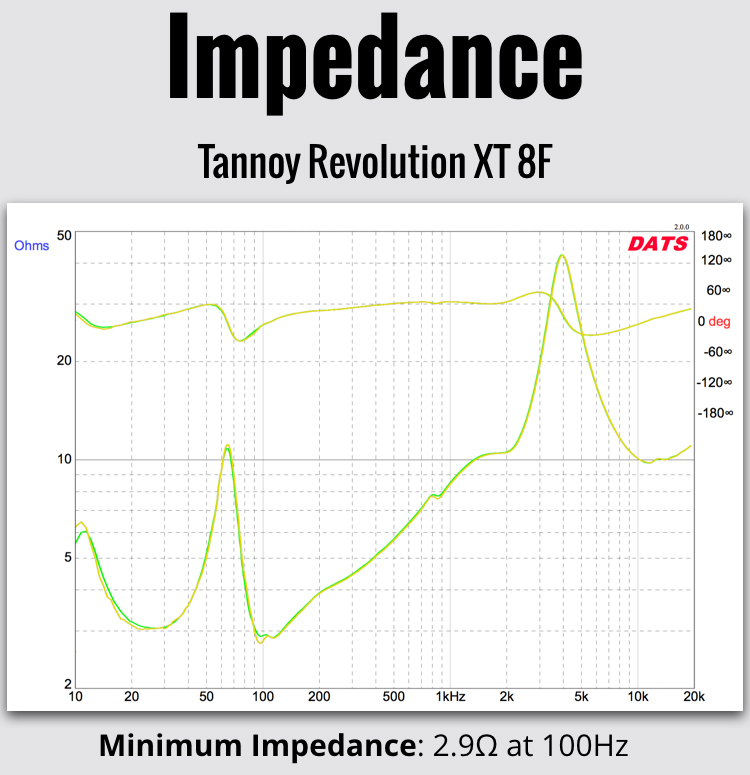
All three speakers track well. The bobble in their impedance curves at 800-900 Hz may be a reflection from the woofer surround. The impedance swings widely, with a minimum below 3 Ohms in the upper bass and a maximum of over 40 Ohms. The flattened “saddle” from 20 – 30 Hz shows the port tuning, and the damping effect of the twin-chamber reflex enclosure. The slight knee at about 200Hz likely indicates where the lower woofer starts rolling off. Due to the low upper bass impedance, use a stout separate amp for optimal performance. The widely-swinging impedance means tube amps will sound significantly different than solid state amps.
The next graph shows the Tannoy Revolution XT 8F’s acoustic crossover. This graph is highly smoothed to show broad trends in frequency response.

The big surprise here is the acoustic crossover point: closer to 2.5 kHz than the specified 1.8 kHz. The tweeter filter is relatively shallow down to 1.8 kHz, whereupon it loses waveguide loading and its response plunges. The woofer rolls off smoothly at roughly a second-order slope, with no evident break-up. The tweeter extends an octave less than Tannoy’s claimed 32 kHz upper limit.
Arguably the single graph that best predicts how a speaker will sound in a room is a polar map. A polar map shows a slice of a speaker’s radiation across a whole plane (usually horizontal) rather than just at one point. As Dr. Floyd Toole recently noted in a lecture at McGill University, “what we want is a loudspeaker that maintains something resembling a constant directivity over a wide range of frequencies. In that way and only in that way will we achieve this ideal performance of the direct sound matching the timbre of the reflected sounds.”
Unfortunately, polar maps rarely appear in hi-fi speaker reviews. Other examples of polar maps may help for context, particularly if you can find polar maps of speakers you’ve heard. My speaker reviews here at Secrets provide polar maps when practicable. For additional context, Princeton University’s 3D3A Labs maintains a database of polar maps with home, pro, and DIY speakers. Additionally, Dr. Earl Geddes maintains a sophisticated, albeit not Mac/iDevice compatible, polar map database app. (Use external sites or apps at your own risk!)
The polar maps below chart the Tannoy Revolution XT 8F’s frequency response over the horizontal plane, measured in 5-degree increments. The “edge” (-6dB point) of their horizontal dispersion pattern is yellow. The “Raw Response” polar map shows horizontal dispersion as is. “Normalized to On Axis” shows horizontal dispersion with the speakers equalized ruler-flat on axis to 20kHz. The dotted lines denote 90-degree dispersion.
Because the Revolution XT 8F is quite flat on axis, the two polar maps are similar below 14kHz. Aside from some “waistbanding” (narrower dispersion) in the 3kHz – 6kHz octave, the off axis response nicely matches the on axis response. Importantly, there is no dispersion disruption (large flare of upper midrange energy) when the tweeter comes in. Omnimagnet’s cone and Torus Ogive Waveguide keep things very smooth until about 3kHz. Treble dispersion is remarkably constant from 6 kHz until the treble cutoff.
In an absolute sense, the Revolution XT 8F’s has narrow dispersion by hi-fi speaker standards. For example, Bryston’s Mini A has markedly wider dispersion. The narrower-than-usual dispersion may contribute to the exceptional low-level resolution I noted while listening, because a speaker with narrower dispersion will provide a higher ratio of direct sound to reflected sound at the listening position.
To satisfy my curiosity if Omnimagnet truly offered wider dispersion than previous Dual Concentrics, I also measured a set of mid-1990s Tannoy System 8 NFM II studio monitors with 8-inch “Tulip” Dual Concentrics. I normalized the polar maps below to better compare dispersion, as the System 8 NFM II has rougher on axis frequency response than the Revolution XT 8F.
Both speakers offer roughly 90-degree dispersion through the midrange, but the XT 8F provides an additional octave of constant dispersion. This improvement verifies Tannoy’s claim that Omnimagnet “provides wider high frequency directivity” than previous Dual Concentrics. Perhaps this wider treble dispersion enables the XT 8F to throw a soundstage wider than the speakers’ outer edges, while the System 8 NFM II’s soundstage is constrained in width to the outer edges of the speakers.
The next graph shows the XT 8F’s vertical frequency response up to 25 degrees off axis, smoothed 1/6-octave to show broad trends. The towers could not fit on my turntable sideways, so angle values are nominal. Also, I could not raise the XT 8F towers high enough to take stable measurements below the tweeter axis, so all measurements shown are above the tweeter axis.
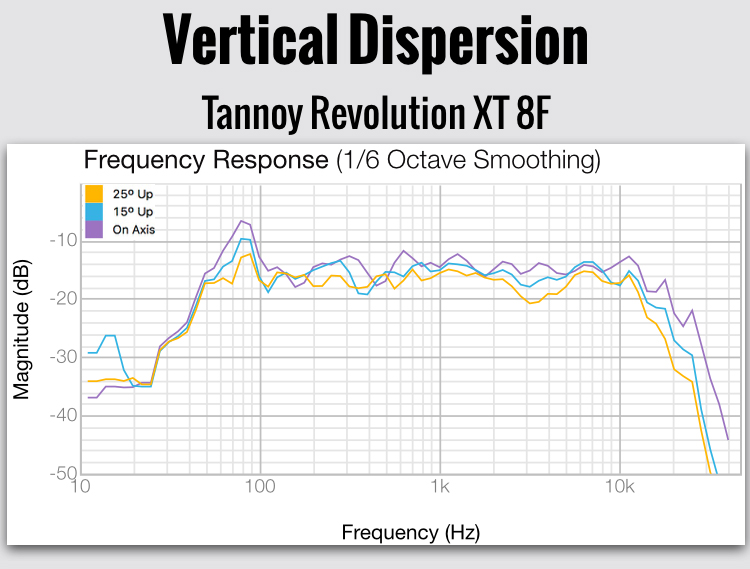
Secrets’ Technical Editor, Dr. David Rich, called 2.5-way speakers “never to be purchased” in his Phase Technology PC3.5 review. In 2.5-ways, the helper woofer usually interferes with the primary woofer, causing erratic vertical dispersion. These dispersion problems can cause abrupt tonality shifts when moving from seated to standing, and color the sound while seated as well. The XT 8F is an exception to the rule. Perhaps Tannoy avoids the usual problems of 2.5-way speakers because the 8-inch supplemental woofer is larger than usual. Compared to the 5-to-7-inch woofers in most 2.5-way systems, an 8-inch woofer has narrower midrange dispersion. Narrow midrange dispersion means less midrange interference than typical 2.5-way system with 5-to-7-inch woofers.
The next figure shows the nearfield “NRC Listening Window” response, which averages five frequency response measurements: on axis and 15 degrees off axis left, right, up, and down.
The Revolution XT 8F has admirably flat response. Its listening window response fits into a roughly 5dB window from 300Hz – 10kHz at 1/12 octave smoothing. As always, a 1/3-octave smoothed listening window average is provided for comparison purposes. One thing to note: the window sizes at 1/12-octave and 1/3-octave smoothing don’t differ greatly. That suggests Tannoy carefully designed the drivers and cabinet to minimize resonances. This smoothness of response is another likely factor in the speakers’ superb low-level resolution.
In addition to nearfield measurements, I measured each XT 8F at my listening position using the “Localized Sound Power” method. Each measurement below is a spatial average of six points, with Anthem ARC turned off.
Three takeaways from these graphs.
First, the Revolution XT 8F is genuinely full-range. The bass extends down to the 20’s. With such deep extension, and two 8-inch woofers per side, subwoofers are strictly optional for a single seated music listener. However, multiple subwoofers will provide more consistent bass response over several listening positions, which no speakers positioned for midrange and treble performance can offer.
Second, in-room response in the modal region (roughly 50Hz – 400Hz) is abysmal for all three speakers. Even worse, there are large differences between each speaker! Blame the unfortunate realities of small room acoustics, not Tannoy. That is why “correcting the room” so improves tonality and realism on high quality speakers, and why I consider room correction necessary for high-fidelity sound. The two room correction systems thus far explored in Secrets technical articles, Anthem ARC (used for my auditions) and Dirac Live can correct room problems without overriding the speakers’ native voicing. My Denon AVR-4100W measurements show Audyssey MultEQ XT32’s “Bypass LR” mode performs very well for 2-channel listening, though Audyssey does change the speakers’ voicing in any other mode. Hopefully Secrets will explore the in-room performance of other room correction systems, but for now I can only speak to these three systems.
Third, all three speakers have identical deep bass response. No EQ can fix the 40Hz suckout, but response is smooth from that suckout until the XT 8F’s port tuning. DSP room correction primarily improves the modal region, not the deep bass.
I took all of the above measurements with grilles off. However, I mostly listened with grilles on. The magnetic grilles did have some measured effect on the Revolution XT 8Fs. The graphs below show the minor difference in frequency response (overwhelmingly dips) between grilles on and off at four angles.
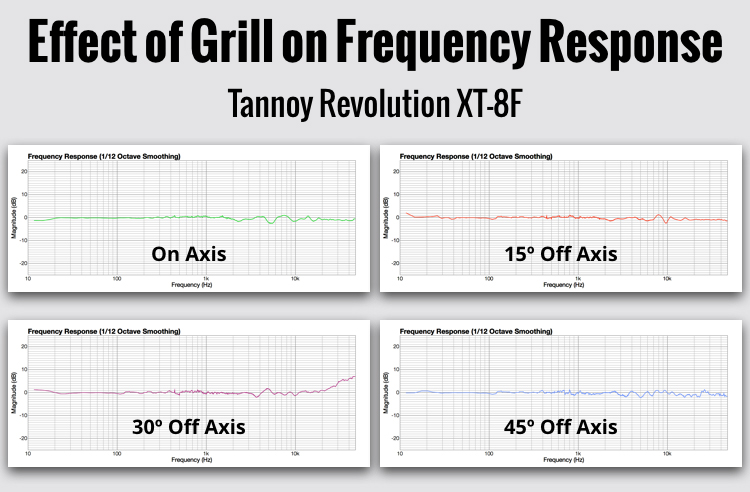
The psychoacoustic benefit of concealing the drive-units exceeded the grilles’ sonic impact for me.
THE TANNOY REVOLUTION XT 8F is a beautiful sounding, great looking, genuinely full-range speaker.
- Low-level resolution
- Lower midrange palpability
- Dynamic get-up-and-go
- Appearance and build quality
- Even midrange/treble dispersion that allows consistent tonality and stable imaging at multiple listening positions
- An end to the tyranny of spikes
- A tiny bit more treble refinement
- A dedicated center channel of similar scale in the Revolution XT line
Without putting too fine a point on it, if we didn’t have a fireplace front-and-center in our living room we’d probably host three Tannoy Revolution XT 8Fs as long-term guests. They sounded great on every track, video, TV show, and movie we threw at them. Three Tannoy Revolution XT 8Fs are also naturals for a dedicated theater with a projector, because they combine extraordinary low-level resolution and All-Pro dynamic freedom. Their measurements, both on and off axis, back up my listening impressions. If you can fit three in your room, do it.
Furthermore, everything that makes the Tannoy Revolution XT 8F amazing in multichannel – low level resolution, spectral evenness, image stability over a large seating area, dynamic reserves, midrange tone color reproduction, etc. – translates directly to 2-channel listening. Tannoy offers a number of smaller Revolution XT speakers for center and surround channels, ideal for a system biased to 2-channel music that also shows the occasional flick. Perhaps Tannoy will consider adding a larger Revolution XT center channel for people who want the full experience but cannot permanently fit three identical towers up front.
Like the Tannoy Revolution XT 8F’s, all high quality speakers can benefit from DSP room correction. Speakers capable of moving this much air suffer more from room nodes than less capable speakers. As shown by the in-room measurements included in this review, rooms do nasty things to the upper bass response – applying room correction takes advantage of full-range speakers. I will never set up a system without it.
While $1,300 per speaker is not cheap, I think the Tannoy Revolution XT 8F fits into the sweet spot of the performance-price curve, and earns a value-for-money bonus for its’ nicely finished cabinet. Few if any similarly-priced speakers offer the Revolution XT 8F’s heady combination of top-notch full-scale sonic performance, attractive design, and excellent build quality. Highly recommended.


